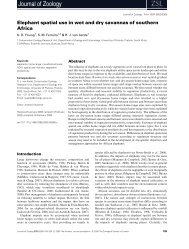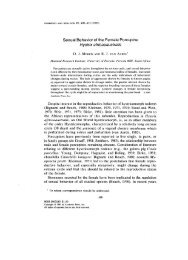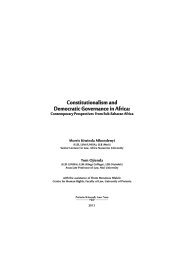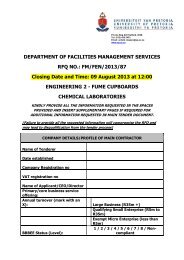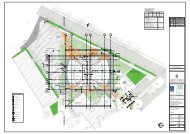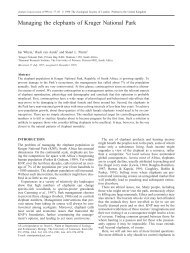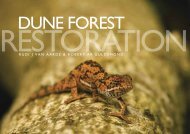Dune forest restoration - CERU
Dune forest restoration - CERU
Dune forest restoration - CERU
- No tags were found...
Create successful ePaper yourself
Turn your PDF publications into a flip-book with our unique Google optimized e-Paper software.
DUNE FORESTRESTORATIONRUDI J VAN AARDE, THEO D WASSENAAR & ROBERT AR GULDEMOND2009
2 D U N E F O R E S T R E S T O RATION
CONTENTS5 INTRODUCTION9 SUCCESSION –CYCLE OF LIFE11 DISTURBANCE15 DETERMINANTS OF RESTORATION SUCCESS16 RBM’S FOREST REHABILITATION PROGRAM2318COMPONENTS OF THE FORESTREHABILITATION PROGRAM21 ECOLOGICAL RESEARCHLeft: Blue CommelinaIndangabaneCommelina erectaAll photographsused in thispublication weretaken in the RBMmining lease areasby RUDI VAN AARDE23 OUR WORK IN CONTEXT25 THE FUTURE27 OUR PUBLICATIONS3 D U N E F O R E S T R E S T O RATION
4 D U N E F O R E S T R E S T O RATION
INTRODUCTIONR E S T O R AT I O N E C O L O G I S T S A S S I S T W I T H T H E R E C O V E R Y O F E C O S Y S T E M S T H AT H AV EBEEN DAMAGED. Such <strong>restoration</strong> is crucialin the fight to counter the loss of biodiversitywrought by a variety of human activities.We prepared this booklet for the non-specialistto show that ecological concepts can beused to manage the <strong>restoration</strong> of a coastaldune <strong>forest</strong> in South Africa. The <strong>restoration</strong> ofthese dune <strong>forest</strong>s is an essential part of theactivities of Richards Bay Minerals (RBM) thatmine coastal sand dunes for minerals such as ilmenite, rutile andzircon. These minerals are essential to the region’s economic wellbeing,and so are the coastal dunes. The <strong>forest</strong> on these dunes is partof the internationally recognised Maputaland Centre of Endemism.We are therefore comitted to conserve them. RBM’s <strong>restoration</strong> programis an ambitious project that places emphasis on the recoveryof indigenous ecological processes that will re-establish coastal dune<strong>forest</strong>s.The <strong>restoration</strong> of an ecosystem requires a thorough interpretationand application of ecological information. The <strong>restoration</strong> programin the mining lease areas of RBM relies on succession and disturbanceas key ecological concepts. Succession is the colonisation ofa disturbed habitat by species adapted to handle prevailing localconditions. Succession thus enables many ecosystems to recoverafter disturbances. In ecological terms natural disturbances disruptthe structure and function of an ecosystem and in many cases suchdisturbances are essential for the maintenance of biodiversity.From an ecological perspective mining partly mimics other largescale natural disturbances. It therefore makes sense to rely on principlesof ecological succession to restore dune <strong>forest</strong>s after they havebeen destroyed by mining. This can include assisting pioneer treespecies that naturally flourish in all kinds of disturbed areas in theregion, to establish and to initiate succession and patch-dynamicsafter the mining of sand dunes.Ecological succession can be initiated on mined sand dunes. This issupported by our 18 year-long study of ecological change and regenerationpatterns in seven indicator groups. Our research also predictsthat most species may return to the mined areas within about 50years after the start of succession. But success is not assured, simplybecause <strong>restoration</strong> is influenced by many forces, these include thosethat operate on the surrounding landscapes. From ecological theory,we also know that the spatial arrangement and size of <strong>forest</strong> patches,be they regenerating or intact, control the rate at which plants andanimals colonise suitable habitats. In our study such <strong>forest</strong> patches5 D U N E F O R E S T R E S T O RATION
are threatened by activities other than mining. This may derail <strong>forest</strong>regeneration and thus calls for 1) the active protection of dune <strong>forest</strong>fragments to sustain the colonisation of previously mined areasthrough natural dispersal, and 2) the management of disturbancesthat may influence dispersal and colonisation rates.The success of a <strong>restoration</strong> program relies on enabling ecologicalprocesses, on maintaining intact <strong>forest</strong> patches and on managingdisturbances such as fire and grazing. Our continuous assessmentof these management activities enables RBM to build its adaptiverehabilitation program on ecological processes. <strong>Dune</strong> <strong>forest</strong>s thatdevelop through these processes also provide local people with avariety of ecological services.Ecosystems are structured in a complex manner and consist of manyinteracting parts that respond to changing conditions. We thereforehave no guarantees that a particular combination of species (community)will recur after they have been removed by either natural orunnatural disturbances. Restoration provides a test of our understandingof the ecological principles that dictate their recurrence,both across time and space. Predicting the response of species andecosystems to <strong>restoration</strong> allows us to design adaptive managementinterventions that tinker with complex processes. The question ofwhether we understand the consequences of our managementdepends on how successful our actions are in restoring the systemthat we have disturbed. Therefore, <strong>restoration</strong> ecology in essenceprovides the knowledge to kindle the maintenance of biodiversity asa conservation ideology.Ecology focuses on the forces that maintain biodiversity – biodiversityin turn is the engine of life on earth. It touches people’s lives inmany important ways. In this booklet we explain some ecologicalconcepts associated with the response of biodiversity to disturbanceand succession because these are central themes in the regenerationof coastal dune <strong>forest</strong>s after mining. We explain how the rehabilitationprogram is based on these fundamental ecological concepts andhow the monitoring of the outcome of the rehabilitation programenables us to assess its success. We also describe some of ourresearch findings on different life forms of the <strong>forest</strong>.Finally, we discuss important management issues, and sketch thedirection that the rehabilitation program should take in the future.6 D U N E F O R E S T R E S T O RATION
7 D U N E F O R E S T R E S T O RATION
8 D U N E F O R E S T R E S T O RATION
SUCCESSION – CYCLE OF LIFESUCCESSION IS AN ECOLOGICAL PROCESS THAT GIVES RISE TO TIME RELATED CHANGES IN THES T R U C T U R E A N D F U N C T I O N O F E C O S Y S T E M S .Succession usually results in the addition and or replacement ofspecies through natural colonisation of suitable habitat, therebychanging ecosystems from a primary to a climax state. The habitatneeds of species and the roles they play form their niche dimensions,which in turn rely on complex interactions between biologicaland physical processes. The photographs on these pages show howdunes are colonised by Acacia karroo (a pioneer tree), which isreplaced by mid-succession species, and ultimately by climax <strong>forest</strong>species. This sequence of changes in species composition and livingconditions is the outcome of ecological succession.However, the path of ecological succession does not always lead toa predictable and singular climax because non-equilibrium forcessuch as patch dynamics may provide for more than one outcome.Succession and other forces of change provide suitable opportunitiesfor a variety of <strong>forest</strong> plants and animals to colonise new habitatsfrom elsewhere. Consequently the variety of species that live on theregenerating dune <strong>forest</strong>s changes in numbers and identity with timesince the initiation of rehabilitation. Our research focuses on thesechanges, the processes that govern them and the similarity of eachstage of regeneration to the bench-mark state typical of undisturbeddune <strong>forest</strong>s.RBM’s rehabilitation program provides opportunity for the regeneration of a coastal dune <strong>forest</strong> through ecological succession.From left to right: 2, 12, 16, 20, 24 and 30 year old rehabilitating vegetation.9 D U N E F O R E S T R E S T O RATION
1 0 D U N E F O R E S T R E S T O RATION
DISTURBANCED I S T U R B A N C E I S A D I S C R E T E E V E N T T H A T D I S R U P T S E C O L O G I C A L S T R U C T U R EAND FUNCTION - it is an essential part ofnature. Disturbances can be recognised onalmost every scale. At a small scale a singledrop of water may disturb a community oftiny organisms, while at larger scales a hurricanemay disrupt most animals and plantsin a <strong>forest</strong>.Disturbance is also an important process forthe maintenance and enhancement of biological diversity (defined asthe diversity of species, types within a species and the diversityof ecological processes). Viewed from a broader perspective it isapparent that disturbance creates heterogeneity (variability) in anecological system, allowing a variety of organisms to coexist and tomaintain a diversity of processes that deliver important ecologicalservices. Disturbances vary in intensity and scale. Disturbances alsooccur at different places and times across landscapes. Through theprocess of patch dynamics this asynchrony creates landscapesthat consist of various stages of succession. Such heterogeneouslandscapes are more stable than those that are more homogenous.It is important to know how plants, animals and ecosystems respondto disturbances. These responses, singly or collectively, will determinethe resilience (the rate at which a system regains its structureand function) and resistance (the length of time it resists changes inthe face of a disturbance) that collectively bring about stability. Someof these responses may be predictable, with the system always tendingto change to a former state. However, such predictable behaviouris rare in nature. More commonly ecosystems change in unpredictableways. Understanding the reasons and identifying the driversfor such non-equilibrium dynamics is a key to successful <strong>restoration</strong>and a challenge for the <strong>restoration</strong> manager who has to make decisionsin the face of uncertainty.Large herbivores, such as cattle, also disturb vegetation on variouslevels and scales. For instance, a fresh dung pile is high in ammoniaand other substances that are not good for plants in such highconcentrations. Moreover, herbivores trample plants and soils,thereby increasing the chances for erosion and, depending onspecies, either stimulate or inhibit growth and regeneration. Largescale disturbances degrade vegetation and destabilise ecosystems. Ifgiven an opportunity some vegetation should recover from thisdisturbance (if it is resilient enough), and ecological stability will beregained. The challenge is to recognise the scale at which to determinewhether disturbance has led to degradation or not.1 1 D U N E F O R E S T R E S T O RATION
Severe disturbances, such as large-scale changes of land use by people,can lead to ecological degradation. Management to restoreecosystems that have been damaged in these ways is expensive andrequires intensive involvement. Strip mining, as conducted in ourstudy area, is a relatively short but intense local disturbance that removesall species and consequently destroys ecosystem structureand function. Strip mining destroys vegetation and leaves no habitatfor plants and animals to survive. Mining therefore removes naturalgoods and services provided by an intact <strong>forest</strong> system. Althoughsimilar disturbances can also occur in nature (e.g. cyclone Domoina),there are many reasons to expect that a dune <strong>forest</strong> will not necessarilyregenerate of its own accord. Intervention, based on the similaritiesand differences between damage induced by mining and bynatural disturbances, is therefore crucial.STRUCTURE OR FUNCTIONINTACT OR DESIRED CONDITIONRESTORATIONREHABILITATIONREVEGETATIONDEGRADATIONDEGRADED CONDITIONTIMEIn this diagram we illustrate the changes that theoretically may occurin response to active <strong>restoration</strong> after mining. Here the degraded statethat exists immediately after mining lacks ecological structure (thediversity and identity of species) and function (the ability to captureand cycle energy and minerals). Through <strong>restoration</strong> managementthe ecosystem recovers its structure and function over time and maydevelop to an intact state (the dark green circle in the diagram) thatrepresents the restored state. An ecosystem that has been placed alongthe developmental trajectory towards the intact state is rehabilitating,meaning that it is in the process of being restored. An ecosystem thatrecovers some of its function but not all of its structure, has beenrevegetated (the blue circle in the diagram), while one that does notrecover any structure or function remains in a degraded state (thebrown circle in the diagram).1 2 D U N E F O R E S T R E S T O RATION
1 3 D U N E F O R E S T R E S T O RATION
1 4 D U N E F O R E S T R E S T O RATION
DETERMINANTSOF RESTORATION SUCCESSWHAT DETERMINES RESTORATION SUCCESS? T H E A N S W E R T O T H I S Q U E S T I O N P R O V I D E SA ROAD MAP for management.It could be a matter of removingthe obstacles that stand inthe way of success, at the sametime supporting processes thatwill ensure success. However,there are many other factorsthat will influence the outcomeof a <strong>restoration</strong> initiative, somethat can be managed, but others that are beyond management. Forinstance, rainfall regimes, the ecology of inter-continental migratoryspecies, the occurrence of disease, social unrest, economic uncertaintiesand political interpretation of environmental laws are allbeyond the control of <strong>restoration</strong> managers.Our work focuses on the ecological problems that face a <strong>restoration</strong>manager. Because RBM has defined their <strong>restoration</strong> objective as thereinstatement of coastal dune <strong>forest</strong>s on one third of their minedlease area (the other two thirds are planted with a commercialspecies for charcoal production) we focus our research on theecological factors that determine coastal dune <strong>forest</strong> <strong>restoration</strong>.We therefore study and compare patterns in intact <strong>forest</strong>s, spontaneouslyregenerating <strong>forest</strong>s and rehabilitating <strong>forest</strong>s. Our workfocuses on how and why ecological variables change across timeand space in these <strong>forest</strong>s. This enables us to define the consequencesof secondary disturbances for colonisation, the interactionsbetween species that drives colonisation and extinction, and the wayanimals and plants colonise the <strong>forest</strong>s.IMPORTANTDRIVERS OFRESTORATIONSUCCESS• Stability of ecological processes• Availability and maintenance of sources of species pools to colonise regenerating landscapes• Environmental laws and regulations• Company environmental policy• Shareholder expectations and management structure• Needs and perceptions of neighbouring communities and future land owners• Land use practises in surrounding landscapes• Effective monitoring and evaluation of rehabilitation• Scientific research on ecological questions• An adaptive <strong>restoration</strong> and management strategy1 5 D U N E F O R E S T R E S T O RATION
RBM’S FORESTREHABILITATION PROGRAMR B M R E L I E S O N E C O L O G I C A L S U C C E S S I O N A N D O N PAT C H D Y N A M I C S T O R E G A I NCOASTAL DUNE FOREST on dunes that they have mined. tat about 25 years after kick-starting succession. In spite of this aboutAnnual exotic seeds are sown in indigenous topsoil that is thinly 60 per cent of <strong>forest</strong> tree species are still not present after somespread over reshaped dunes. This stabilises conditions for the developmentof an early grass cover. Grasses are replaced by dense stands management protocols to ensure and stabilise the recovery process.32 years of development. This calls for the development of adaptiveof indigenous Acacia karroo trees that serve as pioneers.Different to plants, most beetles, millipedes, spiders, mammals andWithin ten years these quick-growing pioneers form a woodland birds that commonly occur in intact dune <strong>forest</strong>s also occur incanopy that provides the conditions needed by broad-leaved <strong>forest</strong> rehabilitating areas. Some <strong>forest</strong> specialists, especially among thetree and shrub species to colonise. From 15 years on canopy gaps birds, continue to be either rare or absent, for reasons we are nowform naturally as some trees die. This initiates the dynamics that studying. The pattern of regeneration of <strong>forest</strong>s on areas rehabilitatedallow mid- and late successional trees to establish and become part by RBM is very similar to that which we study on disturbed areasof the new canopy. At this stage a sub-canopy layer of shrubs and that are regenerating spontaneously in the region.creepers is well-established, leading to a structured dune <strong>forest</strong> habi-RESTORATION MANAGEMENT FACES A CHALLENGE: natural systems often behave in unpredictableways. Management therefore requires a careful approach to decision making, and a sound basis for predictions.Science and the scientific method of setting and assessing hypotheses provides for these predictions. For thatreason, <strong>restoration</strong> management at RBM is based on the principles of adaptive management that allows forcontinuous evaluation of outcomes and the proactive implementation of educated decisions. Managementoutcomes are carefully monitored against defined objectives, and management is adapted on the basis ofnew information. Adaptive management can therefore be defined as “learning by doing”.1 6 D U N E F O R E S T R E S T O RATION
1 7 D U N E F O R E S T R E S T O RATION
COMPONENTS OF THE FORESTRESEARCHMONITORINGThe rehabilitating mining lease areas serve as our outdoor laboratory.Questions arising from problems identified by us or by management,or from our monitoring program are investigated throughresearch. These questions often are addressed as part of our peerreviewedpapers and post-graduate dissertations.Criteria that we have developed during 18 years of research allowedus to develop methods to predict the rate and direction of ecologicalchanges towards the endpoints of <strong>restoration</strong>. These endpoints aretargets that may or may not be reached within the time frame of active<strong>restoration</strong> management. Factors that may limit processes thatcan lead to these endpoints continue to be investigated through theresearch program that provides the basis for the monitoring program.To monitor the outcome of RBM’s rehabilitation program we studytime and spatial related changes in the number of individuals perspecies, the number of species (richness), diversity, species composition,and the way the system recycles nutrients. Along with soilproperties such as Carbon and Nitrogen contents, and bio-assays ofsoil fertility, we survey important <strong>forest</strong> life forms such as trees,herbs, millipedes and birds. Monitoring is an essential componentof the <strong>restoration</strong> program and it is important that we set and definereasonable <strong>restoration</strong> targets. We consequently measure, describeand characterize undisturbed dune <strong>forest</strong>s to set <strong>restoration</strong> targets.These ‘reference’ <strong>forest</strong>s provide benchmarks against which weevaluate <strong>restoration</strong> success. This means that we check that thedevelopment of the rehabilitating areas can lead to an intact <strong>forest</strong>.1 8 D U N E F O R E S T R E S T O RATION
REHABILITATION PROGRAMEVALUATIONIMPLEMENTATIONBased on information obtained through research and monitoring,we decide whether the rehabilitation program is still on track. Weevaluate the information in the light of general ecological modelsand knowledge, as well as our own experiences. We then take a decisionto adapt current management practices, instigate new ones, orstart new research projects where information seems insufficient. Forthe evaluation it is important that suitable indicators of <strong>restoration</strong>success are selected and measured. These indicators should representthe structure and function of a dune <strong>forest</strong> as well as the naturalvariability that is typical of an intact or regenerating dune <strong>forest</strong>.These indicators must meet certain criteria, which define thestandards against which we judge <strong>restoration</strong> success.Management objectives which stem from research and monitoringdefine the management targets. Specific management actions toachieve these objectives are then implemented and the outcomethereof is carefully monitored. Implementation includes physicalactions such as the shaping of dune profiles, the spreading of acertain volume and quality of topsoil, the structured removal of alienvegetation and control of grazing by cattle, fire prevention and theprotection of fragments of <strong>forest</strong>s that serve as source pools.1 9 D U N E F O R E S T R E S T O RATION
2 0 D U N E F O R E S T R E S T O RATION
ECOLOGICAL RESEARCHO U R R E S E A R C H P R O G R A M F O L L O W S S C I E N T I F I C P R O T O C O L S T O D E T E R M I N E T I M EAND SPACE RELATED CHANGES in the species composition.It estimates the number of individuals and species in each of thetaxa that we have elected to study and to monitor. Species are identifiedagainst herbarium and other reference collections.Our sampling protocols meet international standards and we placeemphasis on measuring variability and the precision of all estimates.For instance, we use distance survey methodologies to estimate birdnumbers. We take special care to ensure the repeatability from yearto year and from one survey area to another. Our plant and millipedesurvey quadrates are also replicated and randomly locatedwithin each of the sampling sites. These quadrate surveys allow usto estimate species-specific densities and several variables that reflecton community structure.The completeness of sampling is determined using rarefactionprotocols through which accumulation curves are designed. Thesecurves represent the cumulative number of species that have beenseen as a function of sampling effort. This approach ensures bothcost efficiency and scientific rigour.We analyse data and compare our results against ecological theories,hypotheses and our own empirical experience over the years. Ourapproach ensures that the monitoring of ecological recovery meetsscientific criteria and improves our understanding of the dynamics ofdune <strong>forest</strong>s. Postgraduate training is integral to our approach andwe regularly disseminate our findings at national and internationalconferences. Regular feedback meetings to mining managementalso ensure that our research findings are implemented.2 1 D U N E F O R E S T R E S T O RATION
2 2 D U N E F O R E S T R E S T O RATION
OUR WORK IN CONTEXTT H E R E C O V E RY O F A N E C O S Y S T E M R E L I E S O N N AT U R A L P R O C E S S E S T H AT B R I N G A B O U TD E S I R A B L E PAT T E R N S . Modern conservation focuses onmaintaining and restoring these patterns. This stabilises the processesthat supply vital ecological services to people. Predicting patternsand processes is the core business of ecological sciences and <strong>restoration</strong>ecology rightly deserves the status of an ‘acid test for ecosystemdynamics’. RBM’s commitment towards long-term ecologicalresearch in a natural research laboratory lends opportunity to refinethese ‘acid tests’ – this is the core of our academic program on <strong>forest</strong>recovery and <strong>restoration</strong> in and around the RBM mining lease areas.The application of <strong>restoration</strong> ecology needs well designed actionplans that may have long-term outcomes. The implementation ofthese plans is costly and as scientists we have to ensure that ourprotocols meet the qualities dictated by the academic world. We dothis by publishing our findings in scientific journals (see the referencelist at the end of this booklet and the complimentary CD in theback cover). This assures exposure to a peer-reviewing system thatis typical of primary scientific activity. We also present our work atlocal, national and international scientific symposia and relevantworkshops. Our annual technical reports and frequent meetings aidin the planning of RBM’s rehabilitation activities.Some 18 years of research support by RBM explicitly allowed forfreedom of expression and provided for continuity and a platformto build academic and applied capacity within the field of <strong>restoration</strong>ecology. To this end, 28 postgraduates have completed their studiesin this program.2 3 D U N E F O R E S T R E S T O RATION
2 4 D U N E F O R E S T R E S T O RATION
THE FUTUREADAPTIVE MANAGEMENT BY DEFINITION REQUIRES CONTINUAL UPDATING BASED ON THEFINDINGS OF RESEARCH and monitoringprotocols. The life expectancy ofmining and active rehabilitation is muchshorter than the time that may beneeded for the full development of anindigenous and self-sustaining coastaldune <strong>forest</strong>. RBM’s rehabilitationprogram emphasises the establishmentand maintenance of a self-sustaining<strong>forest</strong> regeneration process that has a high likelihood of giving riseto a dune <strong>forest</strong> typical of the region. Such a goal rather than oneof establishing a dune <strong>forest</strong> per se, makes both ecological andeconomic sense and can be achieved within the lifetime of themining operation.Long-term ecological studies have an advantage over studies conductedover short periods in that complex patterns often only showthemselves after a number of years of study. In our quest to guideRBM in their effort to rehabilitate a severely disturbed system, wecontinue to describe new phenomena, and test current theoreticalmodels that have been published by us and others.Restoration management cannot ignore the effects of landscape characteristicson the colonisation of rehabilitating areas by <strong>forest</strong>species. In the future our research therefore will continue to focuson the implications of landscapes for colonisation, extinction anddispersal so as to improve the management of rehabilitation.The monitoring program will also be adapted to fit into thisapproach. We will continue to improve cost efficiency by seeking thesimplest indicators of ecological structure and function.2 5 D U N E F O R E S T R E S T O RATION
2 6 D U N E F O R E S T R E S T O RATION
OUR PUBLICATIONSDavis, A.L.V., van Aarde, R.J., Scholtz, C.H. & Delport, J.H. (2002)Increasing representation of localized dung beetles across a chronosequenceof regenerating vegetation and natural dune <strong>forest</strong> in South Africa. GlobalEcology and Biogeography 11, 191-209.Davis, A.L.V., van Aarde, R.J., Scholtz, C.H. & Delport, J.H. (2003)Convergence between dung beetle assemblages of a post-mining vegetationalchronosequence and unmined dune <strong>forest</strong>. Restoration Ecology 11, 29-42.Dippenaar-Schoeman, A.S. & Wassenaar, T.D. (2002) A checklist of theground-dwelling spiders of coastal dune <strong>forest</strong>s at Richards Bay, South Africa(Arachnida: Araneae). Bulletin of the British Arachnological Society 12,275-279.Dippenaar-Schoeman, A.S. & Wassenaar, T.D. (2006) A checklist of spidersfrom the herbaceous layer of a coastal dune <strong>forest</strong>s ecosystem at RichardsBay, KwaZulu-Natal, South Africa (Arachnida: Araneae). African Invertebrates47, 63-70.Ferreira, S.M. & van Aarde, R.J. (1996) Changes in community characteristicsof small mammals in rehabilitating coastal dune <strong>forest</strong>s in northernKwaZulu/Natal. African Journal of Ecology 34, 113-130.Ferreira, S.M. & van Aarde, R.J. (1997) The chronosequence of rehabilitatingstands of coastal dune <strong>forest</strong>s: do small mammals confirm it? SouthAfrican Journal of Science 93, 211-214.Ferreira, S.M. & van Aarde, R.J. (1999) Habitat associations and competitionin Mastomys-Saccostomus-Aethomys assemblages on coastal dune<strong>forest</strong>s. African Journal of Ecology 37, 121-136.Ferreira, S.M. & van Aarde, R.J. (2000) Maintaining diversity throughintermediate disturbances: evidence from rodents colonizing rehabilitatingcoastal dunes. African Journal of Ecology 38, 286-294.Foord, S.H., van Aarde, R.J. & Ferreira, S.M. (1994) Seed dispersal byvervet monkeys in rehabilitating coastal dune <strong>forest</strong>s at Richards Bay. SouthAfrican Journal of Wildlife Research 24, 56-59.Greyling, M.D., van Aarde, R.J. & Ferreira S.M. (2001) Seasonal changesin habitat preferences of two closely related millipede species. African Journalof Ecology 39, 51-58.Jackson, T.P. & van Aarde, R.J. (2003) Sex- and species-specific growthpatterns in cryptic African rodents, Mastomys natalensis and M. coucha.Journal of Mammalogy 84, 851-860.Jackson, T.P. & van Aarde, R.J. (2004) Diet quality differentially affectsbreeding effort of Mastomys coucha and M. natalensis: implications for rodentpests. Journal of Experimental Zoology Part A: Comparative ExperimentalBiology 301A, 97-108.Jackson, T.P. & van Aarde, R.J. (2004) Do Mastomys natalensis pupsdevelop more quickly than M. coucha pups? African Zoology 39, 153–156.Koekemoer, A.C. & van Aarde, R.J. (2000) The influence of food supplementationon a coastal dune rodent community. African Journal of Ecology38, 343-351.Kritzinger, J.J. & van Aarde, R.J. (1998) The bird communities of rehabilitatingcoastal dunes at Richards Bay, KwaZulu-Natal. South African Journalof Science 94, 71-78.Kumssa, D.B., van Aarde, R.J. & Wassenaar, T.D. (2004) The regenerationof soil micro-arthropod assemblages in a rehabilitating coastal dune <strong>forest</strong> atRichards Bay, South Africa. African Journal of Ecology 42, 346-354.Neluvhalani, M.J., Ferreira, S.M. & van Aarde, R.J. (1995) The effect(s)of carbaryl-treated seed on body maintenance and survival of the multimammatemouse, Mastomys natalensis (sensu lato). Onderstepoort Journal ofVeterinary Science 62, 235-240.Redi, B.H., van Aarde, R.J. & Wassenaar, T.D. (2005) Coastal dune <strong>forest</strong>development and the regeneration of millipede communities. RestorationEcology 13, 284-291.2 7 D U N E F O R E S T R E S T O RATION
Smit, A.-M. & van Aarde, R.J. (2001) The influence of millipedes onselected soil elements: a microcosm study on three species occurring oncoastal sand dunes. Functional Ecology 15, 51-59.van Aarde, R.J., Ferreira, S.M. & Kritzinger, J.J. (1996) Millipedecommunities in rehabilitating coastal dune <strong>forest</strong>s in northernKwaZulu/Natal, South Africa. Journal of Zoology, London 238, 703-712.van Aarde, R.J., Ferreira, S.M. & Kritzinger, J.J. (1996) Successionalchanges in rehabilitating coastal dune communities in northernKwaZulu/Natal, South Africa. Landscape and Urban Planning 34, 277-286.van Aarde, R.J., Coe, M. & Niering, W.A. (1996) On the rehabilitation ofthe coastal dunes of KwaZulu-Natal. South African Journal of Science (News& Views) 92, 122-124.van Aarde, R.J., Ferreira, S.M., Kritzinger, J.J., van Dyk, P.J., Vogt, M. &Wassenaar, T.D. (1996) An evaluation of habitat rehabilitation on coastaldune <strong>forest</strong>s in northern KwaZulu-Natal, South Africa. Restoration Ecology 4,334-345.van Aarde, R.J., Smit, A-M & Claassens, A.S. (1998) Soil characteristics ofrehabilitating and unmined coastal dune <strong>forest</strong>s. Restoration Ecology 6, 102-110.van Aarde, R.J., Wassenaar, T.D., Niemand, L., Knowles, T. & Ferreira,S.M. (2004) Coastal dune <strong>forest</strong> rehabilitation: a case study on rodent andbird assemblages in northern KwaZulu-Natal, South Africa. In: Coastal sanddunes: Ecology and <strong>restoration</strong> (Eds Martinez, M.L. & Psuty, N.), SpringerVerlag, Heidelberg.Wassenaar, T.D. & van Aarde R.J. (2001) Short-term responses of rehabilitatingcoastal dune <strong>forest</strong> ground vegetation to livestock grazing. AfricanJournal of Ecology 39, 329-339.Wassenaar, T.D., van Aarde, R.J., Pimm, S.L. & Ferreira, S.M. (2005)Community convergence in disturbed subtropical dune <strong>forest</strong>s. Ecology 86,655-666.Wassenaar, T.D., Ferreira, S.M. & van Aarde, R.J. (2007) Flagging aberrantsites and assemblages in <strong>restoration</strong> projects. Restoration Ecology 15, 68-76.Wassenaar, T.D. & van Aarde, R.J. (2008) Towards better <strong>restoration</strong> assessment:a review of the bioindicator concept in rehabilitation. Proceedings of theThird International Seminar on Mine Closure, 14-17 October, Johannesburg,South Africa.Weiermans, J. & van Aarde, R.J. (2003) Roads as ecological edges for rehabilitatingcoastal dune assemblages in northern KwaZulu-Natal, SouthAfrica. Restoration Ecology 11, 43-49.Copies of these research publications are available on a CD and at www.ceru.up.ac.zaD E S I G N A N D P RO D U C T I O N: LORETTA S T EYN G R A PHIC D E S I G N S T U D I O –PR E TO R I Aloretta@icon.co.zaPrinted on Sappi Triple Green TM paper – Sugar cane fibre, chlorine-free, sustainable af<strong>forest</strong>ation. Bagasse is used and all pulp is bleached using an elementalchlorine-free process, complying with stringent regulations of the US Environmental Protection Agency and the World Health Organisation. Pulping chemicals go througha chemical recovery plant, waste water undergoes rigorous treatment and solid waste is recovered to use as soil enhancer to regenerate harvested sugar cane lands.2 8 D U N E F O R E S T R E S T O RATION






